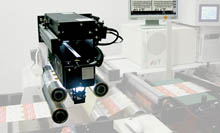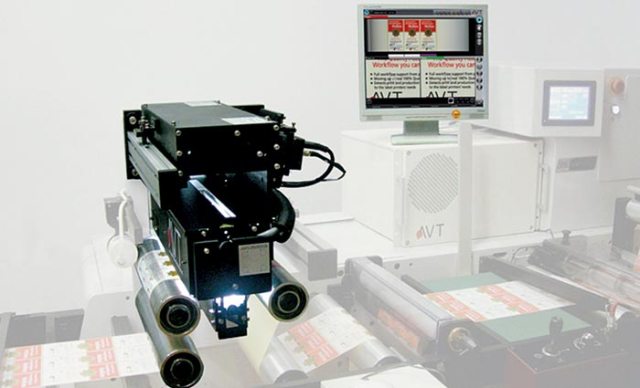
What does it do?
The AVT PrintVision/Helios II inspection system aims to provide quality assurance in label and narrow web printing. Accord-ing to AVT, the system detects all printing defects such as colour misregister, colour variations, hazing, misprints, text defects, spots, splashes, die-cut problems, barcode problems and missing labels.
What machines is it compatible with?
AVT says the device can be used with all presses and finishing systems, but is most effective when installed on a press. The optional workflow module launched in conjunction with Helios II ensures that, not only is the operator notified when a defect occurs, but that the unwinder also automatically stops the roll at exactly the right point to allow an operator to remove the faulty labels. AVT’s marketing manager Guy Yogev says: “Six years ago, most inspection systems in the label market were installed on rewinders. But that’s really much too late. If you find out about the defect at the printing stage, you can dramatically cut waste, reduce costs and boost production.”
Russell Robertson, sales director at local distributor DES, says this trend is reflected in the Australian market. “Our install base has more than 50% of the installs going on the press.”
When was it launched and what market is it aimed at?
AVT launched the first Helios II eight years ago and aims to update it each year. DES took over the agency three years ago. This year’s version was launched in July in response to demand from the US pharma-ceutical market for a system that could verify any type of barcode or set of human readable variable numbers, checking for decoding, readability, quality, missing codes, duplications or sequence problems.
How does it work?
After a short set-up process, the system’s camera takes a master image of the printed product, which the operator must approve as of acceptable quality. They can then adjust the quality threshold for the job in question, the preferences for which can be saved as profiles. The system then uses algorithms to detect defects, with particular attention to label-specific faults, such as character defect detection, die-cut miss-register, and matrix removal problems. The Helios II also performs a check against an original PDF file to ensure that the correct job is being processed. “I’ve had a lot of customers saying ‘we printed a marvellous job, thousands of good quality labels, but it was the wrong job to begin with,’” says Yogev. “It could be the wrong revision, the wrong plates, the wrong language, and is a huge waste of time and money for them.”
What is its USP?
AVT says Helios II is the most suitable inspection system for checking labels at the printing stage. Upgrades such as the workflow module, barcode verification and colour measurement module are all designed to make fault detection at an early stage as reliable as possible. AVT says the key selling point is the simple interface and high level of automation.
Yogev says: “Because we’re developing more and more modules, the system is in danger of becoming more complex. So we invest 50% of our development budget into keeping the system as simple as possible. Another feature that we feel has always differentiated Helios systems is the ability to identify important defects while ignoring those that aren’t, such as very small spots or very slight colour changes.”
Robertson says users like that quality control can save on costs. “A lot of customers are looking at Helios II for lifting the quality benchmark, but also as a cost-reduction tool. That is a major drier now: printing the correct product without the errors and mistakes.”
What training and support is available?
DES takes full responsibility for training, having invested significantly in ensuring local engineers are up to speed on the AVT technology.
“We can do the whole install, service and support without support from AVT. We can dial into any of the systems and analyse it at DES or at AVT depending on the time of the day,” says Robertson
How much does it cost?
The base system starts at about $80,000 then the price goes up depending on the configurations required, such as camera chosen and whether it is colour or black and white. Robertson says the average package would be $90,000-$100,000.
What is the sales target?
AVT has installed more than 800 Helios inspection systems worldwide and has already upgraded around 20 Helios II systems since it was launched in July. Locally, DES is well ahead of target, with 10 systems already sold this year.
Comment below to have your say on this story.
If you have a news story or tip-off, get in touch at editorial@sprinter.com.au.
Sign up to the Sprinter newsletter


